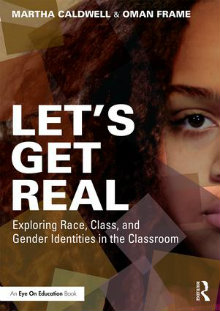Race, Class, & Gender in the Classroom
Let’s Get Real: Exploring Race, Class, and Gender Identities in the Classroom
By Martha Caldwell and Oman Frame
(Routledge/Eye On Education, 2017 – Learn more)

In The Outsiders, tough-kid Ponyboy does a frog dissection in science class. Without thinking, he pulls out a switchblade to use as a scalpel. His wealthier classmates freak out. He feels miserable.

We can call these moments microaggressions. And we know what they are – we can notice them in literature and in life. We can talk about these moments and then begin to notice our own behavior and the behavior of those around us in a different way.
The first few chapters of Let’s Get Real provide a theoretical groundwork for social justice education around race, class, and gender. Caldwell and Frame cite social justice educators like Ernest Morrell, Paolo Friere, and bell hooks towards developing their theory of Transformational Inquiry.
Inviting Students to Create Their Knowledge
Transformational Inquiry’s tenets include valuing personal experiences and emotions in conversation, building knowledge as a community through conversation, and encouraging students towards being uncomfortable. These principles can empower and engage voices, values, experiences, and ideas that might otherwise go unheard.
After building a general theory, the authors organize the book around the constructs of gender, race, and class. Each section includes a bank of relevant lesson plans, activities, and videos. The authors also invite readers to sign up via their website for more lesson plans.
Theory and Practice
I always appreciate when professional texts blend theory with practice, as this book does. However, I would have appreciated advice for teachers who want to use a Transformational Inquiry framework on how they can approach administrators and parents who may have questions. Discussions about oppression, bias, and privilege aren’t inherently connected to contemporary politics, but some community members may interpret them as such.
Additional Questions and Concerns
Another concern is the balance between building a group identity versus valuing an individual’s take. One lesson in this book invites students into the inner circle to a talk based on group identity while others listen.
For example, white women might be invited into the inner circle while others listen in on to the experience of white women. While this activity is a valuable way to learn about others’ experiences, what does a teacher do about students who are questioning their gender identity? Or what about students who may “pass” as white but identify as multiracial? Do these activities put undue pressure on students to publicly self-identify based on what others may assume to be true?
While most teachers may not have the time, resources, or capital to enact units of study the way these teachers are able to, English and social studies teachers can adapt individual lessons and lesson plans in this book to connect to the content they already teach.
Amy Estersohn is a middle school English teacher who blogs at Three Teachers Talk and reviews comic books for No Flying No Tights. She is a 2016 recipient of the Gallo Grant from the NCTE’s Assembly on Literature for Adolescents.


































